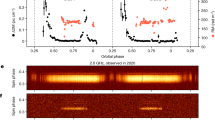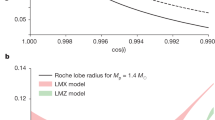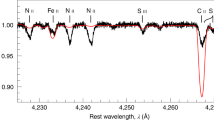Abstract
THREE-BODY interactions can eject stars, singly or in binaries, from the core of a globular cluster to its outskirts, whither dynamical friction may take more than 108 yr to return them. We show here that such a process can explain why the binary pulsar 2127 + 11C in the cluster Ml5 (and perhaps 1744–24A in Terzan 5) is now far from the cluster core. A suitable encounter could have given the pulsar enough velocity to eject it to its present position, and also replaced its original stellar companion with a neutron star. For ejection of PSR2127 +11C to be likely, the core of M15 must be composed of heavy degenerate stars at a density greater than 107pc-3, maintained for ≳108yr; this is consistent with previous dynamical estimates. A natural combination of factors enables us to see 2127 + 11C: a binary of longer period could not have received a large enough impulse to escape the core, whereas one of shorter period would have been ejected from the cluster or would have collapsed because of orbital decay by gravitational radiation. Pulsars and pulsar binaries ejected from clusters will contribute to the birth rate of recycled pulsars in the inner Galaxy.
This is a preview of subscription content, access via your institution
Access options
Subscribe to this journal
Receive 51 print issues and online access
$199.00 per year
only $3.90 per issue
Buy this article
- Purchase on SpringerLink
- Instant access to full article PDF
Prices may be subject to local taxes which are calculated during checkout
Similar content being viewed by others
References
Charles, P. A. in Proc. 23rd ESLAB Symp., Topics in X-ray Astronomy, ESA SP-296 Vol. 1 (ed. White, N.), 129–137 (European Space Agency, Paris, 1989).
IIovaisky, S. A. in Proc. 23rd ESLAB Symp., Topics in X-ray Astronomy, ESA SP-296 Vol. 1 (ed. White, N.) 145–150 (European Space Agency, Paris, 1989).
Anderson, S. B., Gorham, P. W., Kulkarni, S. R., Prince, T. A. & Wolszczan, A. Nature 346, 42–44 (1990).
Lugger, P. M., Conn, H., Grindlay, J. E., Bailyn, C. D. & Hertz, P. Astrophys. J. 320, 482–492 (1987).
Anderson, S. B., Kulkarni, S. R., Prince, T. A. & Wolszczan, A. Nature (submitted).
Seitzer, P., Peterson, R. & Cudworth, K. in Dynamics of Dense Stellar Systems (ed. Merritt, D.) 153–156 (Cambridge University Press, 1989).
Peterson, R. C., Seitzer, P. & Cudworth, K. M. Astrophys. J. 347, 251–265 (1989).
Phinney, E. S. Mon. Not. R. astr. Soc. (in the press).
McMillan, S. L. W. Astrophys. J. 306, 552–564 (1986).
Hut, P. & Inagaki, S. Astrophys. J. 298, 502–520 (1985).
Murphy, B. W., Cohn, H. N. & Hut, P. Mon. Not. R. astr. Soc. 245, 335–349 (1990).
Chernoff, D. F. & Djorgovski, S. Astrophys. J. 339, 904–918 (1989).
Kulkarni, S. R., Narayan, R. & Romani, R. W. Astrophys. J. 356, 174–183 (1990).
Taylor, J. H. & Weisberg, J. M. Astrophys. J. 345, 434–450 (1989).
Burrows, A. & Woosley, S. Astrophys. J. 308, 680–684 (1986).
King, I. R. Astr. J. 71, 64–75 (1966).
Shara, M. M., Moffatt, A. F. J. & Potter, M. Astr. J. 99, 1858–1862 (1990).
Lauer, T. R. et al. Astrophys. J. (in the press).
Author information
Authors and Affiliations
Rights and permissions
About this article
Cite this article
Phinney, E., Sigurdsson, S. Ejection of pulsars and binaries to the outskirts of globular clusters. Nature 349, 220–223 (1991). https://doi.org/10.1038/349220a0
Received:
Accepted:
Issue date:
DOI: https://doi.org/10.1038/349220a0
This article is cited by
-
Computational methods for collisional stellar systems
Living Reviews in Computational Astrophysics (2023)
-
Short gamma-ray bursts from binary neutron star mergers in globular clusters
Nature Physics (2006)
-
Primordial black holes in globular clusters
Nature (1993)



